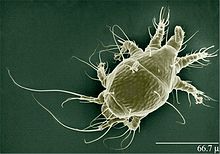Tarsonemidae is a family of mites, also called thread-footed mites or white mites.
Only a limited number of tarsonemid genera (Steneotarsonemus, Polyphagotarsonemus, Phytonemus, Floridotarsonemus and Tarsonemus) are known to feed on higher plantswhile most species in this family feed on the thin-walled mycelia of fungi or possibly algalbodies.[1] Even among the plant-feeding tarsonemid mites, most are confined to areas of new growth where cell walls are thin and therefore easily pierced. However two species (the "broad mite" Polyphagotarsonemus latus and the "cyclamen mite" Steneotarsonemus pallidus) are able to feed on older leaves because of their ability to inject toxins during feeding (presumably of salivary gland origin) causing an increase of thin walled cells surrounding feeding sites.[1] This proliferation of new growth often results in leaves that appear stunted, puckered and twisted.[1]
| Tarsonemidae | |
|---|---|
 | |
| Acarapis woodi | |
| Scientific classification | |
| Kingdom: | Animalia |
| Phylum: | Arthropoda |
| Subphylum: | Chelicerata |
| Class: | Arachnida |
| Subclass: | Acari |
| Order: | Trombidiformes |
| (unranked): | Heterostigmatina |
| Superfamily: | Tarsonemoidea |
| Family: | Tarsonemidae Kramer, 1877 |
| Diversity | |
| 45 genera, > 500 species | |
No comments:
Post a Comment